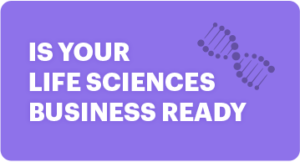Risk Assessment: 5 Essential Tools Used by Life Science Companies
Risk Assessment in Life Sciences
Risk assessment is a critical component of life sciences operations, as it helps organizations identify and address potential threats to safety, compliance, and efficiency. By performing risk assessments, life sciences companies can reduce their exposure to risks and ensure that their operations are compliant with relevant laws and regulations. In this guide, we’ll explain the basics of risk assessment and look at five different types of risk assessment tools used by life sciences companies, such as health and safety programs, hazard assessment compliance, environmental risk analysis, operational risk assessments, and product risk assessments.
Risk assessment is the process of evaluating risks associated with any given operation, product, or environment. It is a critical part of running a successful life sciences organization as it allows for the identification and management of potential risks. Risk assessment focuses on identifying hazards, assessing their likelihood of occurring, and determining how to mitigate or prevent them. By assessing risks, life sciences companies can make informed decisions about how to reduce or eliminate potential risks.
The benefits of risk assessment include better management of resources, improved adherence to safety standards, and potentially higher profits due to reduced costs associated with damages. In the life sciences industry, risk assessment tools are used to protect the health and safety of employees, customers, and the general public. They are also used to maintain regulatory compliance and minimize financial losses resulting from accidents and incidents.
Risk assessment is an important part of any life sciences company as it helps identify areas of vulnerability and offers solutions to help reduce or eliminate the risks. By understanding the risks associated with their operations, life sciences companies can create a safer work environment and develop safe and reliable products.
There are five different types of risk assessment tools used by life sciences companies: health & safety programs, hazard assessment compliance programs, environmental risk analyses, operational risk assessments, and product risk assessments.
Health & Safety Programs are used to identify and assess potential hazards and risks in the workplace, enabling organizations to implement prevention measures and ensure a safe working environment. Health & Safety Programs typically include safety guidelines and procedures, accident and incident reporting systems, maintenance schedules for equipment, and employee training.
Hazard Assessment Compliance Programs are used to ensure that life sciences organizations comply with all applicable federal, state, and local regulations concerning the safety and health of workers. These programs evaluate the risk associated with operations and products, assess how potential risks can be managed, and develop plans to address those risks.
Environmental Risk Analysis Programs analyze the potential environmental risks posed by operations and products in the life sciences industry. This type of program evaluates how the impacts of operations and products on the environment can be minimized and creates plans to mitigate or prevent these impacts.
Operational Risk Assessment Programs focus on assessing and managing the risks associated with operations in life science companies. This type of program can identify potential risks, evaluate the costs and benefits of managing those risks, and develop plans to reduce or eliminate them.
Product Risk Assessments are used to evaluate the potential risks associated with products being developed or manufactured in the life sciences industry. This type of assessment evaluates the safety and efficacy of products to ensure they meet regulatory standards and are safe for consumers to use.
By performing risk assessments on their operations, products, and services, life sciences companies can reduce exposure to risk and ensure a safe and successful business.
Health & safety programs are an important part of risk assessment for life science companies. These programs are designed to identify, assess and manage potential risks that could affect the health and safety of employees. The objectives of health & safety programs include providing a safe working environment, ensuring compliance with laws and regulations, and reducing the chances of accidents or injuries.
The components of a health & safety program typically include a comprehensive risk assessment, an evaluation of the company’s operations, and the development of safety procedures and protocols. The assessment should identify any hazardous materials, activities, and locations which may present risks to employees. It should also evaluate the effectiveness of existing safety measures and recommend any new procedures or policies to minimize risks.
Health & safety programs are used by life science companies to ensure that their operations are carried out in a safe and secure manner. By identifying, assessing, and managing potential risks, these programs help to protect both the employees and the business. With well-designed health & safety programs, life science organizations can provide their employees with a safe working environment and remain compliant with legal requirements.
Hazard assessment compliance programs are an essential part of risk assessment in the life sciences industry. These programs help life science companies analyze the potential risks associated with operations and products, allowing them to make decisions that better protect their business.
A hazard assessment compliance program typically includes a number of components, such as an assessment of the existing operational environment, requirements for safety policies and procedures, identification of potential hazards, and discussion of the methods used to reduce or eliminate said hazards.
These programs help to identify and address potential risks that could result in injury or damage to employees, property, or the environment. In addition, they can help life science companies inform stakeholders, customers, and the public about the safety of their products.
By using hazard assessment compliance programs, life sciences companies can ensure that their operations are safe and that their products meet the required standards. This is beneficial to both the company and its stakeholders, as it helps to promote trust and confidence in their operations and products.
Risk assessment is an important process for life sciences companies in order to mitigate the potential risks associated with their operations. Environmental risk analysis is a type of risk assessment used by life sciences companies that can help them identify and analyze the environmental impacts and potential risks of their activities.
The objective of environmental risk analysis is to assess the current state of the environment in areas where the company operates, identify any potential risks, and evaluate how those risks may be reduced or mitigated. This process also helps companies determine which measures and practices need to be implemented to reduce and manage environmental risks.
Environmental risk analysis includes evaluating the environment for potential hazards such as air pollution, water contamination, soil degradation, and hazardous waste management. It is also used to identify any potential sources of environmental contamination and to assess the potential impact of activities on the surrounding environment. This information can then be used to develop strategies to minimize the environmental impact of the company’s activities and reduce the associated risks.
Furthermore, environmental risk analysis can also provide information on the possible compliance requirements for the company and can help them meet regulations and standards set by local, national, and international authorities. By conducting regular environmental risk assessments, life science companies can be better prepared for any potential environmental impacts and can ensure that they are meeting their legal obligations.
Operational Risk Assessment
An operational risk assessment is an important tool for evaluating and managing the risks associated with operations in life science companies. This type of risk assessment typically includes analyzing the processes, facilities, and personnel operations to identify any potential risks or hazards that could pose a threat to operations. Additionally, operational risk assessments can help life science organizations identify areas for improvement, as well as precautionary measures and procedures for preventing or minimizing the occurrence of risks.
Operational risk assessments may involve examining the company’s systems, processes, and procedures for handling hazardous materials, as well as assessing the effects of various environmental hazards on facilities, products, and personnel. By conducting a thorough risk assessment of an organization’s operations, life science companies can better understand the potential risks their operations may face and plan accordingly.
Product Risk Assessment
Product risk assessment is an important part of any life sciences operation, as it can help companies identify potential issues with their products before they hit the market. Product risk assessment tools evaluate the risks associated with new or existing products, such as potential safety issues, product recalls, or manufacturing defects. They can also help identify areas where product improvements could be made to maximize efficiency and profitability.
Product risk assessments involve analyzing a variety of factors, such as the production process, materials used, storage conditions, safety protocols, and distribution networks. All of these aspects are assessed to determine how well a product fulfills its intended purpose and if any changes need to be made to optimize performance. Companies may also need to consider potential environmental or ethical issues that may arise from particular products or processes.
Product risk assessments are essential for ensuring the safety and reliability of products released by any organization in the life sciences industry. They can also help identify ways to improve efficiency and reduce costs in the production process. By taking the time to assess the risks associated with their products and processes, life sciences companies can provide high-quality products that meet customer needs without sacrificing safety or profits.
Risk assessment is an essential part of ensuring the success of life sciences companies. By assessing potential risks and identifying existing hazards, companies can plan for possible outcomes and inform their decision making process. Five types of risk assessment tools that are commonly used by life sciences companies are health & safety programs, hazard assessment compliance programs, environmental risk analyses, operational risk assessments, and product risk assessments. Through these processes, life sciences companies can protect their employees, customers, and the public from any potential harm caused due to their activities and products. By implementing effective risk assessment processes, life sciences companies can help ensure their operations are successful and responsible.
Citing references is an important part of any article, as it allows readers to verify the facts and assertions being made. In the life sciences industry, accurate and reliable sources are crucial to ensuring the safety and efficacy of products and operations. To ensure readers have access to the most up-to-date information, the sources cited in this guide are from recent peer-reviewed research and publications. All references are clearly marked with hyperlinks to the original source material.
Risk management is an important part of operations for life sciences companies. To ensure safety and compliance, it’s necessary to evaluate and manage potential risks associated with business operations and products. Fortunately, there are many risk assessment tools available to help life sciences companies identify and address any potential issues.
To ensure your company is properly managing risks, it’s important to familiarize yourself with the various risk assessment tools available. This guide will cover five different types of risk assessment tools used by life sciences companies: health & safety programs, hazard assessment compliance programs, environmental risk analyses, operational risk assessments, and product risk assessments.
After reading this guide, you should have a better understanding of the risks facing life sciences companies and the different tools available to help manage them. If you would like more information on risk management in the life sciences industry, there are many resources available online. You can also contact organizations such as the Global Institute of Regulatory Affairs, which provide expertise and guidance in the areas of safety and compliance.
Optimizing blog posts for target search terms and including relevant images or visuals can be an essential part of risk assessment for life sciences companies. By using keywords throughout the post that relate to the main topic of risk assessment, it is easier for potential readers to find your post on search engines. Additionally, adding visuals such as diagrams, infographics, or photographs can also bring more attention to your post and make it more appealing to readers. Not only do visuals provide a sense of clarity to your post, but they can also capture reader’s attention and help to explain complex topics more simply. And by properly optimizing all text and visuals with the correct HTML tags, readers can navigate easily through your post and find the content they are looking for.
FAQs About Risk Assessment in Life Sciences
1. What is risk assessment?
Risk assessment is the process of analyzing the likelihood and consequences of potential risks. It enables life sciences companies to take preventive measures, reduce a risk’s potential impacts, and monitor ongoing risks.
2. What are five types of risk assessment tools used by life sciences companies?
The five different types of risk assessment tools used by life sciences companies include: health & safety programs, hazard assessment compliance programs, environmental risk analyses, operational risk assessments, and product risk assessments.
3. How are health & safety programs used by life science organizations?
Health & safety programs can help life sciences organizations to identify potential safety issues, develop safety policies and procedures, and ensure that employees follow these policies and procedures.
4. What is a hazard assessment compliance program?
Hazard assessment compliance programs are used to analyze the risks associated with business operations and products in the life sciences industry. They involve identifying hazardous materials and activities, assessing their level of risk, and creating control measures to reduce or eliminate those risks.
5. How are environmental risk analysis programs used in the life sciences industry?
Environmental risk analysis programs can help life sciences companies identify potential environmental impacts from their operations and products, assess the relative risks, and design appropriate mitigation strategies.
6. What is the purpose of an operational risk assessment?
Operational risk assessment programs are used to evaluate and manage the risks associated with current and future operations in life science companies. These programs identify potential risks, evaluate the risks in terms of likelihood and severity, and develop strategies for mitigating them.
7. How does product risk assessment aid in the life sciences industry?
Product risk assessment tools help life sciences companies determine the potential risks associated with products they are developing or manufacturing. These tools can help to identify any potential hazards, assess their likelihood and severity, and develop strategies for managing the risks.





